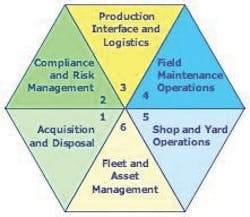The Management Challenge: Equipment Profession Facing Management Reset
The prolonged downturn has forced the nation into an economic reset as government, businesses and citizens adjust to what many are calling the new financial realities. The construction industry has struggled even more with these new realities. Organizations are emphasizing the financial management of their equipment assets, and equipment executives find themselves with more responsibility for and involvement in tasks that directly affect the bottom line.
First in a series, this installment of The Management Challenge introduces the scope of the issues facing fleet managers. Others in the series:
Why Managers are Running the Rental Option
In-House vs. Outsourced Maintenance
The Complexities of Compliance
Rental Strategies Aid Compliance, Costs
Meet the New Boss, Not the Same as the Old Boss
Outsourcing Cuts Shop Costs
This is not a recent development, although the recession has clarified and intensified it. Equipment management has been moving in this direction for nearly 15 years. The new realities of asset management, however, are forcing a management reset for fleets and managers.
Mike Vorster, who consults in the area of fleet management and organizational development, has defined the scope of equipment management as a hexagon, divided into six triangles with each denoting an area of responsibility. The six: acquisition and disposal; compliance and risk management; production interface and logistics; field maintenance operations; shop and yard operations; and fleet and asset management. These six areas must be “competently performed,” Vorster says in his book, “Construction Equipment Economics.”
“Equipment management is a complex and difficult task that affects almost every aspect of a company’s operations,” he writes. “The skills required vary from those of the master mechanic to finance, accounting and organizational behavior.”
Vorster has been performing, researching or teaching equipment management for 50 years and says these tasks aren’t new. What has shifted is the emphasis and responsibility. Fleet and asset management has become more important, and organizations have put that responsibility on the equipment executive.
The economic downturn has intensified that focus, according to Stan Orr, CAE, executive director of the Association of Equipment Management Professionals. “Asset managers are increasingly relied on by ownership to help them make their purchasing, disposal, maintenance-management decisions for the biggest asset that a company owner has,” he says.
Equipment managers are moving into the board room, too, providing input into the decisions that guide the organization as well as the fleet. Thad Pirtle, vice president and equipment manager for Traylor Bros., has a seat at the management table, contributing to the decisions made by this multinational construction company.
Pirtle is also unique in that he is one of the rare breed who reached the pinnacle after starting as a mechanic more than 35 years ago. He credits his development to early management training and his experiences as he assumed more responsibilities as positions opened up within Traylor. Today, Pirtle travels the world overseeing Traylor’s fleet.
Equipment management shifts
This model of management evolution will not serve much longer as today’s managers retire. The shift is on from a maintenance and machine focus to a financial and asset focus. The equipment division is more a business unit than a collection of shops and yards.
“Now there are more folks demanding more out of the position,” says Greg Kittle, CEM, vice president of corporate purchasing at William Charles. “They’re asking those folks to participate in financial matters and balance sheet issues, and all those sorts of things they weren’t involved in before. You see some larger companies pulling talent from other areas than what the traditional path for equipment manager was. Now, a lot of these folks are finance majors or [degreed] professionals.”
Andy Agoos, who co-teaches with Vorster in the Construction Equipment Management Program, agrees. “He’s a different guy,” he says. “He’s computer literate, he excels in Excel. There’s a lot more information that he has to collect. You have huge amounts of data to digest and manage. He spends more time doing analysis than deciding what oil to buy.”
Compliance and risk management have “become huge,” Agoos says, but each of the six functions has become more complicated over the past 15 years. Agoos has managed some of the nation’s largest fleets, and most recently managed fleet assets for Neff Rental before retiring in 2009. Emissions compliance is the most obvious task assigned to equipment managers, but safety and safety regulation also have expanded their responsibilities.
“When you have millions of dollars of equipment that are your primary asset, [owners] are becoming more and more aware of things that they need to stay up on,” Orr says. “They are relying more on the equipment professional to get things done and to know these things. The equipment manager may not know chapter and verse on environmental issues, but they’re trained to know who to call.
“It all boils down to everything being so bottom-line, profit driven [that] you have to have a professional managing your fleet. The bottom line: There is more managing the risk.”
Agoos agrees. “Everyday, today’s equipment manager has to document new things or change something for the sake of compliance. It’s added hours, maybe a 10-percent increase over the past seven years or so. Today, the equipment manager is an administrator. He’s probably 25 percent administration now compared to 5 percent.”
Emissions regulation and compliance has become the biggest contributor to this increase in responsibility. Agoos calls it “massive, bigger than we think.”
Orr calls it “a hornet’s nest. It’s too much for an owner to have to take on. He needs somebody who’s guiding that and keeping up with the latest regulations.”
The equipment profession is at a pivotal point. Owners recognize their need, and the equipment manager is in the position to meet it. Development and attainment of the skills and organization of the department are the challenge facing managers today.
The new breed of manager will require excellent communication and interpersonal skills. “You’re a salesperson to a certain extent,” Pirtle says. “You can have the best ideas in the world, but if you can’t get them communicated in a fashion that accomplishes what your goals are, then it’s all for naught.”
Kittle defines it as a need for marketing skills.
“One of the things that is important to being successful is your relationships with your suppliers,” he says. “You’re continuously marketing your company to everyone. How you present your company is really important. Why is it important for that manufacturer or dealer to want to do business with you? There’s more to a relationship than a financial transaction.”
Equipment and the team that keeps it functioning is a cost because it’s a support organization, Vorster says. Equipment managers will succeed only “through their service and influence and not their ability to make money,” he says. “That makes the interpersonal communication skills terribly important.”
Yet the mechanical side of fleet management cannot be ignored or even de-emphasized. And communication with the technical side of the hexagon is as important a challenge, Vorster says.
“Managers have to be able to interface with the folks whose lives revolve around the wrenches and the oil and the grease,” he says. “Then they have to have the skills so they can interface with the folks whose lives revolve around capital and procurement.”
These skills help define the organizational structure, and as the triangles within the hexagon continue to grow in importance, the function will eventually outgrow the ability for one person to perform all the tasks at levels expected by owners.
“One person doesn’t do everything,” Vorster says. “I think there are certain skills that occur in people together; it’s very seldom that you find high levels of mechanical skills occurring with high levels of finance and accounting skills.
“You can go to the very best and most respected of our equipment management professionals, and they’ll all be missing some piece,” he says.
Many organizations split up the financial and mechanical functions, with the equipment manager handling one and a deputy responsible for the other.
“Public companies are more apt to have it split up because they have more detail in decision-making processes,” Pirtle says. “In a privately owned company, you have the owners and they make the decision. ‘We’re going to buy the iron, go do it.’ In the public companies, it has to go through a process of review and authorization.”
Managing the financial component is critical and primary, Kittle says.
“The structure I’ve employed before would be to have someone who concentrates on the financial aspects of the fleet,” he says. “Then employ a fleet-maintenance manager and perhaps a reliability manager that provides the technical, on-the-ground technical skill sets that you need to execute your work day to day.”
The financial side will drive the profession from here on.
“The business acumen is going to challenge what we think of as the equipment manager,” Orr says. “It’s a double-edged sword. As the profession has grown in stature and evolved, the companies who want to get the best are going to require and demand the very best. They’re going to start writing job descriptions that say you have to have an MBA and years of experience, like any emerging profession.
“In 10 years, he’s going to look significantly different from what he does now,” he says. “We’re not far away from degreed programs in asset management.”
About the Author
Rod Sutton
Sutton has served as the editorial lead of Construction Equipment magazine and ConstructionEquipment.com since 2001.
Our mission is to help managers of heavy equipment and trucks to improve their performance in acquiring and managing their fleets. One way we do that is with our Executive Institute, where experts share information and ideas that will enable equipment managers to accurately manage equipment costs so that they can deliver the optimum financial benefits to their organizations.
We also have a laser focus on product development, performance, and technology; as well as equipment acquisition, disposal, and maintenance. Our exclusive Field Tests take earthmoving equipment and truck into the field for professional evaluations.
Check out our free newsletters to see the latest content.
You can find Sutton on LinkedIn.

